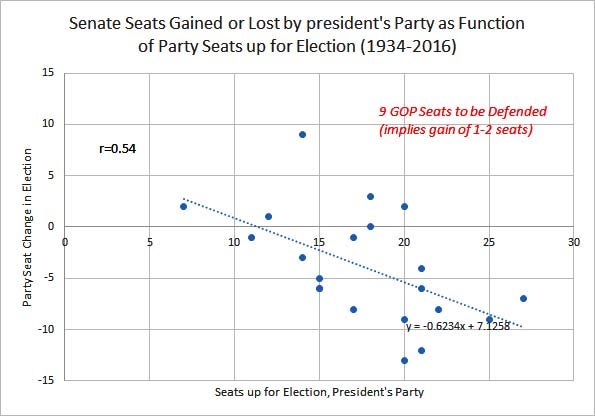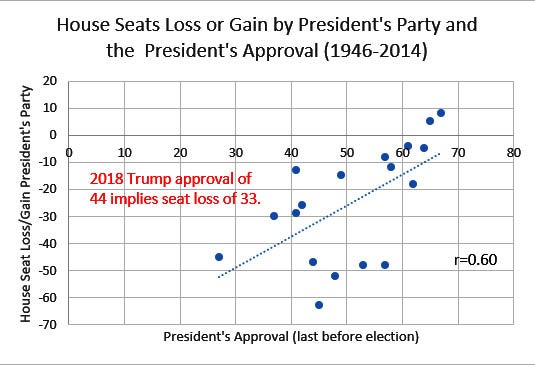| President's Job Approval Percentage (Gallup) As of: | President's Party | Seat Change, President's Party | |||||||||||
| Year | Lame Duck? | President's Party |
Early Aug | Late Aug | Early Sep | Late Sep | Early Oct | Late Oct | House Seats to Defend |
Senate Seats to Defend |
|||
| 1934 | Franklin D. Roosevelt | D | -- | -- | -- | -- | -- | -- |
313
|
14 | +9 | +9 | |
| 1938 | Franklin D. Roosevelt | D | -- | -- | -- | -- | -- | 60 | 334 | 27 | -81 | -7 | |
| 1942 | Franklin D. Roosevelt | D | 74 | -- | 74 | -- | -- | -- | 267 | 25 | -46 | -9 | |
| 1946 | Harry S. Truman | D | -- | -- | 33 | -- | -- | 27 |
244 |
21 | -45 | -12 | |
| 1950 | LD* | Harry S. Truman | D | nd | 43 | 35 | 35 | 43 | 41 |
263 |
21 | ||
| 1954 | Dwight D. Eisenhower | R | 67 | 62 | -- | 66 | 62 | -- |
221 |
11 | -18 | -1 | |
| 1958 | LD | Dwight D. Eisenhower | R | 58 | 56 | 56 | 54 | 57 | -- |
203 |
20 | -48 | -13 |
| 1962 | John F. Kennedy | D | -- | 67 | -- | 63 | -- | 61 |
264 |
18 | -4 | +3 | |
| 1966 | † | Lyndon B. Johnson | D | 51 | 47 | -- | -- | 44 | 44 |
295 |
21 | -47 | -4 |
| 1970 | Richard Nixon | R | 55 | 55 | 57 | 51 | 58 | -- |
192 |
7 | -12 | +2 | |
| 1974 | ± | Gerald R. Ford (Nixon) | R | 71 | -- | 66 | 50 | 53 | -- |
192 |
15 | -48 | -5 |
| 1978 | Jimmy Carter | D | 43 | 43 | 48 | -- | 49 | 45 |
292 |
14 | -15 | -3 | |
| 1982 | Ronald Reagan | R | 41 | 42 | -- | 42 | -- | 42 |
192 |
12 | -26 | +1 | |
| 1986 | LD | Ronald Reagan | R | -- | 64 | -- | 63 | 64 | -- |
181 |
22 | -5 | -8 |
| 1990 | George Bush | R | 75 | 73 | 54 | -- | -- | 57 |
175 |
17 | -8 | -1 | |
| 1994 | William J. Clinton | D | 43 | 40 | 40 | 44 | 43 | 48 |
258 |
17 | -52 | -8 | |
| 1998 | LD | William J. Clinton | D | 65 | 62 | 63 | 66 | 65 | 65 |
207 |
18 | +5 | 0 |
| 2002 | George W. Bush | R | -- | 66 | 66 | 66 | 68 | 67 |
220 |
20 | +8 | +2 | |
| 2006 | LD | George W. Bush | R | 37 | 42 | 39 | 44 | 37 | 37 |
233 |
15 | -30 | |
| 2010 | Barack Obama | D | 44 | 44 | 45 | 45 | 45 | 45 |
257 |
15 | -63 | -6 | |
| 2014 | LD | Barack Obama | D | 42 | 42 | 41 | 43 | 42 | 41 |
201 |
20 | -13 | -9 |
| 2018 | Donald J. Trump | R | 41 | 41 | 39 | 41 | 44 | 44 |
241 |
9 |
-40 | +2 | |
| 2022 | Joseph R. Biden, Jr. | D | 38 | 44 | 44 | 42 | 42 | 40 | 222 | 14 | -9 | +1 | |




